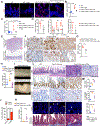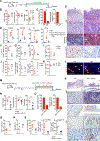Simultaneous Loss of Both Atypical Protein Kinase C Genes in the Intestinal Epithelium Drives Serrated Intestinal Cancer by Impairing Immunosurveillance
- PMID: 30552022
- PMCID: PMC6301096
- DOI: 10.1016/j.immuni.2018.09.013
Simultaneous Loss of Both Atypical Protein Kinase C Genes in the Intestinal Epithelium Drives Serrated Intestinal Cancer by Impairing Immunosurveillance
Abstract
Serrated adenocarcinoma, an alternative pathway for colorectal cancer (CRC) development, accounts for 15%-30% of all CRCs and is aggressive and treatment resistant. We show that the expression of atypical protein kinase C ζ (PKCζ) and PKCλ/ι was reduced in human serrated tumors. Simultaneous inactivation of the encoding genes in the mouse intestinal epithelium resulted in spontaneous serrated tumorigenesis that progressed to advanced cancer with a strongly reactive and immunosuppressive stroma. Whereas epithelial PKCλ/ι deficiency led to immunogenic cell death and the infiltration of CD8+ T cells, which repressed tumor initiation, PKCζ loss impaired interferon and CD8+ T cell responses, which resulted in tumorigenesis. Combined treatment with a TGF-β receptor inhibitor plus anti-PD-L1 checkpoint blockade showed synergistic curative activity. Analysis of human samples supported the relevance of these kinases in the immunosurveillance defects of human serrated CRC. These findings provide insight into avenues for the detection and treatment of this poor-prognosis subtype of CRC.
Keywords: PKCζ; PKCλ/ι; TGF-β; atypical PKCs; colorectal cancer; immunosuppression; immunosurveillance; interferon; intestinal inflammation; serrated adenocarcinoma.
Copyright © 2018 Elsevier Inc. All rights reserved.
Conflict of interest statement
DECLARATION OF INTERESTS
The authors declare no competing interests.
Figures







References
-
- Beaugerie L, and Itzkowitz SH (2015). Cancers complicating inflammatory bowel disease. N Engl J Med 372, 1441–1452. - PubMed
-
- Bennecke M, Kriegl L, Bajbouj M, Retzlaff K, Robine S, Jung A, Arkan MC, Kirchner T, and Greten FR (2010). Ink4a/Arf and oncogene-induced senescence prevent tumor progression during alternative colorectal tumorigenesis. Cancer Cell 18, 135–146. - PubMed
-
- Calon A, Lonardo E, Berenguer-Llergo A, Espinet E, Hernando-Momblona X, Iglesias M, Sevillano M, Palomo-Ponce S, Tauriello DV, Byrom D, et al. (2015). Stromal gene expression defines poor-prognosis subtypes in colorectal cancer. Nat Genet 47, 320–329. - PubMed
Publication types
MeSH terms
Substances
Grants and funding
LinkOut - more resources
Full Text Sources
Other Literature Sources
Molecular Biology Databases
Research Materials

